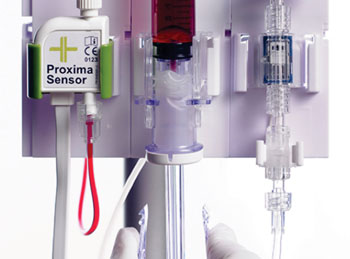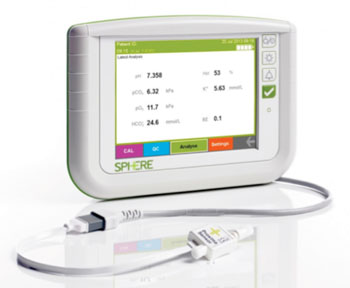Advanced Miniature In-Line Blood Gas Analyzer Launched in Europe
|
By LabMedica International staff writers Posted on 31 Mar 2015 |

Image: The miniature Proxima Sensor is integrated into a patient’s arterial line to be used for directly monitoring blood gases and electrolytes over a 72 hour period as many times as required (Photo courtesy of Sphere Medical).

Image: The new Proxima in-line patient-dedicated point-of-care blood gas analyzer incorporates Proxima Sensor (in foreground) and dedicated bedside monitor (Photo courtesy of Sphere Medical).
A CE-marked patient-dedicated system, presented at ISICEM 2015, delivers point-of-care testing (POCT) by enabling critical care staff to obtain rapid and frequent laboratory-accurate arterial blood gas measurements without leaving the patient’s bedside, facilitating effective and timely clinical decisions.
Sphere Medical (Cambridge, UK) presented its Proxima System at the 35th International Symposium on Intensive Care and Emergency Medicine (ISICEM 2015; Brussels, Belgium, March 17-20, 2015) for launch in mainland Europe. Proxima revolutionizes conventional POCT as it is attached directly to the patient through their arterial line. The miniature Proxima Sensor, containing a range of biological sensors, sits in series in the arterial line with the blood pressure transducer. For the first time, blood gas results can be delivered, like blood pressure results, within the patient’s bed space.
Proxima is simple to use, enables closed blood sampling, and is operated via the touch-screen interface of its dedicated bedside monitor. Blood is withdrawn from the patient directly into the Proxima Sensor and a panel of analytes is measured. All blood is returned to the patient – promoting blood conservation and reducing the possibility of hospital acquired anemia and subsequent transfusions. The disposable sensor can be used for monitoring blood gases and electrolytes over a 72 hour period as many times as required.
Proxima has been fully evaluated and validated in a clinical setting. A recent observational method comparison study at Queen Elizabeth Hospital (Birmingham, UK) showed excellent agreement between Proxima and hospital standard benchtop blood gas analyzers, measuring various parameters of intensive care unit (ICU) patients with a range of clinical conditions, including trauma, head injury, post-surgical recovery, and sepsis.
Dr. Tom Clutton-Brock, senior lecturer, Anaesthesia and Intensive Care Medicine, University Hospital Birmingham, said, “Rapid return of data and swift response to changing blood gases is as essential in-patient care as the continual measurement of blood pressure. Fast feedback and response could have a real impact on efficiently stabilizing patients or weaning them from mechanical ventilation.” At ISICEM 2015 Dr. Clutton-Brock presented on “Bedside Blood Analysis,” discussing how frequent measurement of arterial blood samples is a key component in the effective management of critical care patients, particularly those who are unstable. At a poster session, Dr. Clutton-Brock and Dr. Jess Fox (Sphere Medical) discussed the excellent evaluation results of the Queen Elizabeth Hospital study.
Related Links:
Sphere Medical
35th International Symposium on Intensive Care and Emergency Medicine (ISICEM 2015)
Sphere Medical (Cambridge, UK) presented its Proxima System at the 35th International Symposium on Intensive Care and Emergency Medicine (ISICEM 2015; Brussels, Belgium, March 17-20, 2015) for launch in mainland Europe. Proxima revolutionizes conventional POCT as it is attached directly to the patient through their arterial line. The miniature Proxima Sensor, containing a range of biological sensors, sits in series in the arterial line with the blood pressure transducer. For the first time, blood gas results can be delivered, like blood pressure results, within the patient’s bed space.
Proxima is simple to use, enables closed blood sampling, and is operated via the touch-screen interface of its dedicated bedside monitor. Blood is withdrawn from the patient directly into the Proxima Sensor and a panel of analytes is measured. All blood is returned to the patient – promoting blood conservation and reducing the possibility of hospital acquired anemia and subsequent transfusions. The disposable sensor can be used for monitoring blood gases and electrolytes over a 72 hour period as many times as required.
Proxima has been fully evaluated and validated in a clinical setting. A recent observational method comparison study at Queen Elizabeth Hospital (Birmingham, UK) showed excellent agreement between Proxima and hospital standard benchtop blood gas analyzers, measuring various parameters of intensive care unit (ICU) patients with a range of clinical conditions, including trauma, head injury, post-surgical recovery, and sepsis.
Dr. Tom Clutton-Brock, senior lecturer, Anaesthesia and Intensive Care Medicine, University Hospital Birmingham, said, “Rapid return of data and swift response to changing blood gases is as essential in-patient care as the continual measurement of blood pressure. Fast feedback and response could have a real impact on efficiently stabilizing patients or weaning them from mechanical ventilation.” At ISICEM 2015 Dr. Clutton-Brock presented on “Bedside Blood Analysis,” discussing how frequent measurement of arterial blood samples is a key component in the effective management of critical care patients, particularly those who are unstable. At a poster session, Dr. Clutton-Brock and Dr. Jess Fox (Sphere Medical) discussed the excellent evaluation results of the Queen Elizabeth Hospital study.
Related Links:
Sphere Medical
35th International Symposium on Intensive Care and Emergency Medicine (ISICEM 2015)
Latest Hematology News
- Platelet Activity Blood Test in Middle Age Could Identify Early Alzheimer’s Risk
- Microvesicles Measurement Could Detect Vascular Injury in Sickle Cell Disease Patients
- ADLM’s New Coagulation Testing Guidance to Improve Care for Patients on Blood Thinners
- Viscoelastic Testing Could Improve Treatment of Maternal Hemorrhage
- Pioneering Model Measures Radiation Exposure in Blood for Precise Cancer Treatments
- Platelets Could Improve Early and Minimally Invasive Detection of Cancer
- Portable and Disposable Device Obtains Platelet-Rich Plasma Without Complex Equipment
- Disposable Cartridge-Based Test Delivers Rapid and Accurate CBC Results
- First Point-of-Care Heparin Monitoring Test Provides Results in Under 15 Minutes

- New Scoring System Predicts Risk of Developing Cancer from Common Blood Disorder
- Non-Invasive Prenatal Test for Fetal RhD Status Demonstrates 100% Accuracy
- WBC Count Could Predict Severity of COVID-19 Symptoms
- New Platelet Counting Technology to Help Labs Prevent Diagnosis Errors
- Streamlined Approach to Testing for Heparin-Induced Thrombocytopenia Improves Diagnostic Accuracy
- POC Hemostasis System Could Help Prevent Maternal Deaths
- New Test Assesses Oxygen Delivering Ability of Red Blood Cells by Measuring Their Shape
Channels
Molecular Diagnostics
view channel
New Genetic Test Enables Faster Diagnosis of Rare Diseases
Rare disease diagnosis often involves a long and uncertain search for the underlying genetic cause. Traditional testing requires multiple separate analyses, although many patients remain without answers.... Read more
Urine Test Detects Inherited Neuropathy Missed by Genetic Screening
Sorbitol dehydrogenase (SORD)-related neuropathy is one of the most common inherited nerve disorders, yet diagnosis often lags because current genetic screens frequently miss the causal gene.... Read moreHematology
view channel
Platelet Activity Blood Test in Middle Age Could Identify Early Alzheimer’s Risk
Early detection of Alzheimer’s disease remains one of the biggest unmet needs in neurology, particularly because the biological changes underlying the disorder begin decades before memory symptoms appear.... Read more
Microvesicles Measurement Could Detect Vascular Injury in Sickle Cell Disease Patients
Assessing disease severity in sickle cell disease (SCD) remains challenging, especially when trying to predict hemolysis, vascular injury, and risk of complications such as vaso-occlusive crises.... Read more
ADLM’s New Coagulation Testing Guidance to Improve Care for Patients on Blood Thinners
Direct oral anticoagulants (DOACs) are one of the most common types of blood thinners. Patients take them to prevent a host of complications that could arise from blood clotting, including stroke, deep... Read moreImmunology
view channel
Chip Captures Cancer Cells from Blood to Help Select Right Breast Cancer Treatment
Ductal carcinoma in situ (DCIS) accounts for about a quarter of all breast cancer cases and generally carries a good prognosis. This non-invasive form of the disease may or may not become life-threatening.... Read more
Blood-Based Liquid Biopsy Model Analyzes Immunotherapy Effectiveness
Immunotherapy has revolutionized cancer care by harnessing the immune system to fight tumors, yet predicting who will benefit remains a major challenge. Many patients undergo costly and taxing treatment... Read moreMicrobiology
view channel
Rapid Assay Identifies Bloodstream Infection Pathogens Directly from Patient Samples
Bloodstream infections in sepsis progress quickly and demand rapid, precise diagnosis. Current blood-culture methods often take one to five days to identify the pathogen, leaving clinicians to treat blindly... Read more
Blood-Based Molecular Signatures to Enable Rapid EPTB Diagnosis
Extrapulmonary tuberculosis (EPTB) remains difficult to diagnose and treat because it spreads beyond the lungs and lacks easily accessible biomarkers. Despite TB infecting 10 million people yearly, the... Read more
15-Minute Blood Test Diagnoses Life-Threatening Infections in Children
Distinguishing minor childhood illnesses from potentially life-threatening infections such as sepsis or meningitis remains a major challenge in emergency care. Traditional tests can take hours, leaving... Read more
High-Throughput Enteric Panels Detect Multiple GI Bacterial Infections from Single Stool Swab Sample
Gastrointestinal (GI) infections are among the most common causes of illness worldwide, leading to over 1.7 million deaths annually and placing a heavy burden on healthcare systems. Conventional diagnostic... Read morePathology
view channel
Blood Test and Sputum Analysis Predict Acute COPD Exacerbation
Chronic obstructive pulmonary disease (COPD) remains a major contributor to global illness, largely driven by cigarette smoking and marked by irreversible lung damage. Acute exacerbations can accelerate... Read more
AI Tool to Transform Skin Cancer Detection with Near-Perfect Accuracy
Melanoma continues to be one of the most difficult skin cancers to diagnose because it often resembles harmless moles or benign lesions. Traditional AI tools depend heavily on dermoscopic images alone,... Read more
Unique Immune Signatures Distinguish Rare Autoimmune Condition from Multiple Sclerosis
Myelin oligodendrocyte glycoprotein antibody–associated disease (MOGAD) is a rare autoimmune disorder in which the immune system attacks the myelin sheath in the central nervous system. Although symptoms... Read moreTechnology
view channel
AI Saliva Sensor Enables Early Detection of Head and Neck Cancer
Early detection of head and neck cancer remains difficult because the disease produces few or no symptoms in its earliest stages, and lesions often lie deep within the head or neck, where biopsy or endoscopy... Read more
AI-Powered Biosensor Technology to Enable Breath Test for Lung Cancer Detection
Detecting lung cancer early remains one of the biggest challenges in oncology, largely because current tools are invasive, expensive, or unable to identify the disease in its earliest phases.... Read moreIndustry
view channel
Abbott Acquires Cancer-Screening Company Exact Sciences
Abbott (Abbott Park, IL, USA) has entered into a definitive agreement to acquire Exact Sciences (Madison, WI, USA), enabling it to enter and lead in fast-growing cancer diagnostics segments.... Read more






















